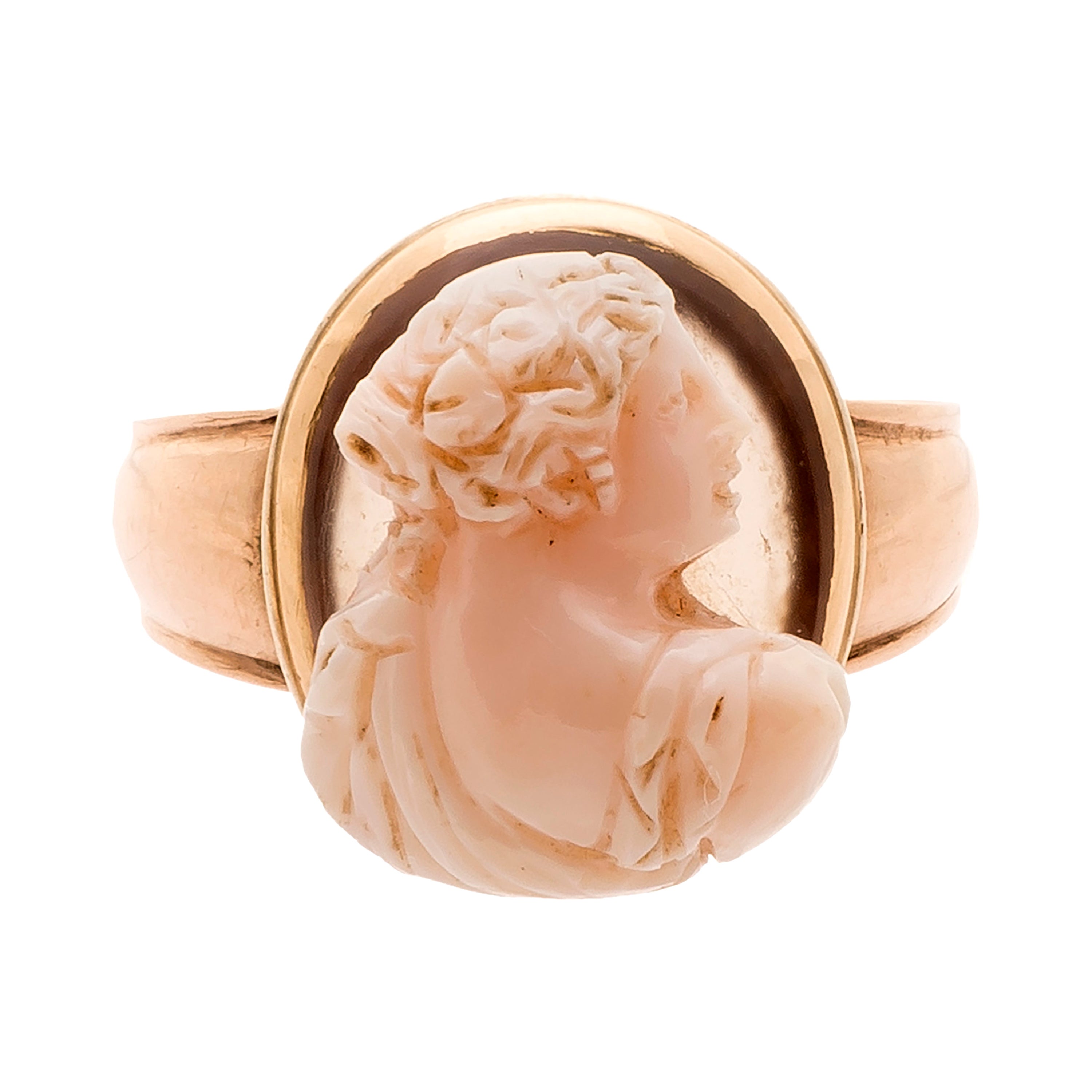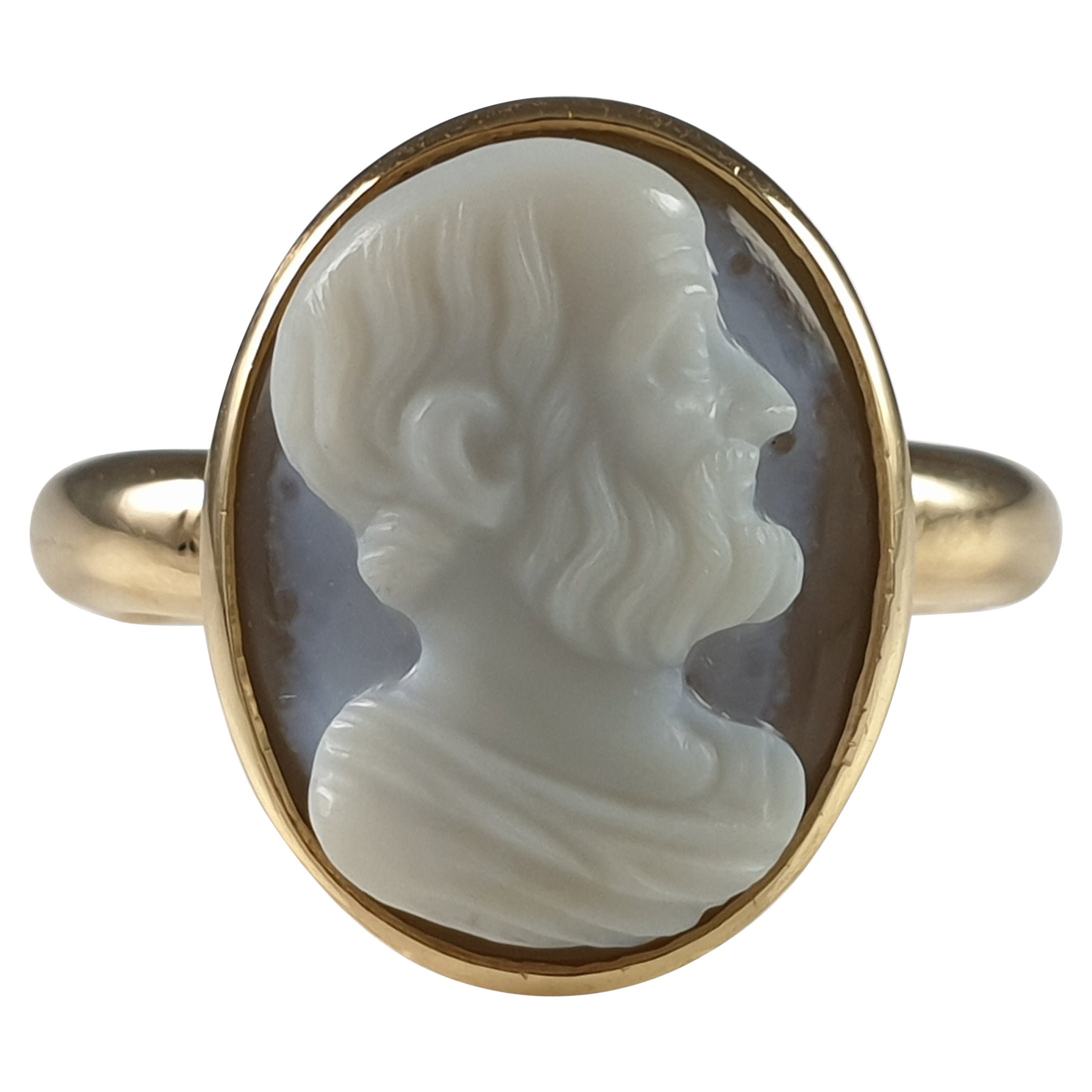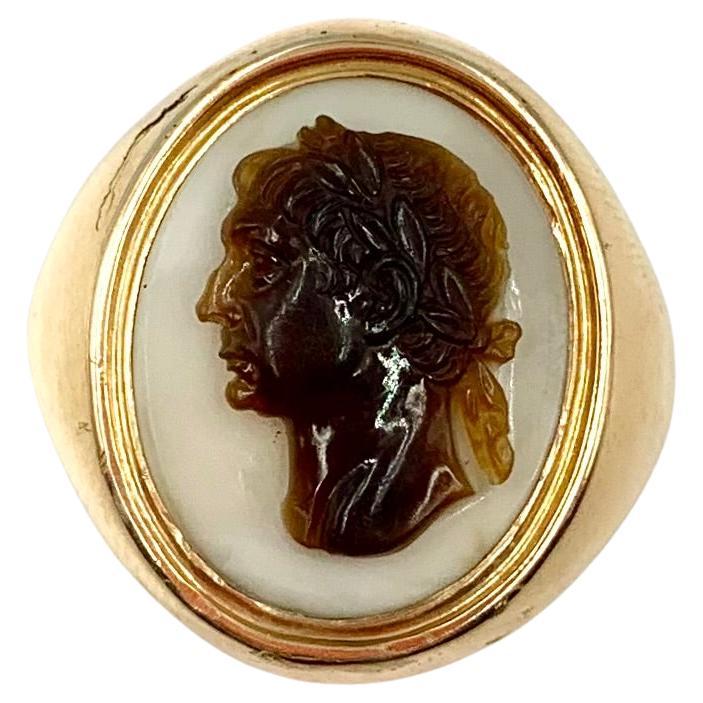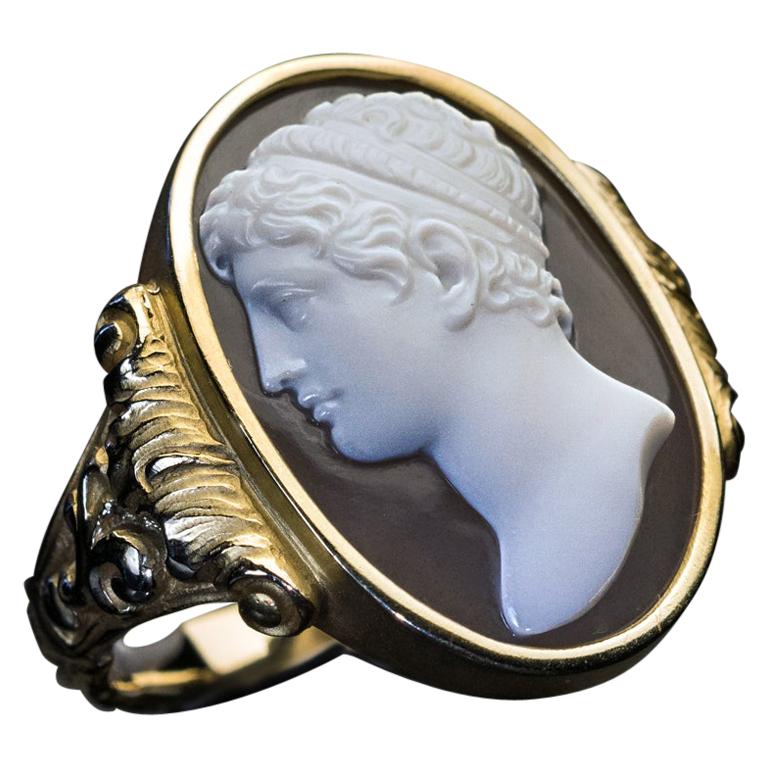Items Similar to Sardonyx cameo of John Milton mounted in English, circa 1901.
Video Loading
Want more images or videos?
Request additional images or videos from the seller
1 of 8
Sardonyx cameo of John Milton mounted in English, circa 1901.
About the Item
Stuart sardonyx cameo of John Milton mounted in a Victorian gold ring. Set with an oval sardonyx 17th century cameo in a rubover setting featuring a profile bust of John Milton (1608-74), the eminent seventeenth century English poet, leading to integrated shoulders and flowing through to a tapering solid shank. Tested yellow gold, English, circa 1901.
- Ring Size:9.75 US, Resizable
- Metal:
- Period:
- Date of Manufacture:1901
- Condition:Wear consistent with age and use.
- Seller Location:London, GB
- Reference Number:
Resizing is available.
About the Seller
5.0
Recognized Seller
These prestigious sellers are industry leaders and represent the highest echelon for item quality and design.
1stDibs seller since 2011
56 sales on 1stDibs
Typical response time: 3 hours
- ShippingRetrieving quote...Ships From: London, United Kingdom
- Return PolicyA return for this item may be initiated within 3 days of delivery.
More From This SellerView All
- John Brogden Shell Cameo Brooch and Earrings, English, circa 1870By John BrogdenLocated in London, GBAntique shell cameo brooch and earrings by John Brogden, English, circa 1870. A yellow gold suite of jewellery, the brooch composed of a horizontally situated oval Bull’s Mouth shell cameo of the Greek goddess Selene riding a serpentine dragon in a rubover collet setting, encircled by a conforming frame of gold beading and twisted gold wire punctuated with four gold palmette form plaques engraved and decorated with dark blue enamel and placed at the cardinal points, the reverse mounted with a hinged pin and scroll clasp, the earrings each composed of a vertical oval Bull’s Mouth shell cameo engraved with a bust length portrait of Selene with crescent-set headdress, encircled by a conforming frame matching that of the brooch with the addition of a pendant decoration composed of a horizontal bar of gold beading and twisted gold wires suspending gold link chains graduated from centre and ending in conical gold elements, the reverses mounted with French wire fittings, all in a fitted red leather case, the interior marked ‘FIRST CLASS PARIS MEDAL/ 1855.1867.1851/ PARIS FIRST CLASS & LONDON PRIZE MEDALS/ JOHN BROGDON/ Goldsmith/ MANUFACTORY/ 16, Henrietta St. Covent Garden/ London’. The cameo—defined as a gem, usually either a mineral or a shell, upon which a design has been carved in relief—is believed to have originated in Hellenistic Greece, during the third century BC. These miniature sculptures, at that time confined to the medium of hardstone, are thought to have been made with the primary purpose of personal adornment. The same practice of mounting cameos in jewellery was then continued by the Ancient Romans, and they are known to have been worn by many a Roman emperor. After the fall of Rome the fashion for cameos went into a decline, until it was again revived during the Renaissance period, brought about by a keen interest in the ancient world. At this time both antique and contemporary cameos were mounted in jewellery, as well as collected as objet d’art. The art of cameo cutting was revived in Italy, where it would remain a centre for the coming centuries. Again there was a lull in interest in carved gemstones, until the Neoclassical revival of the eighteenth century, largely stimulated by the discoveries of the ancient Roman cities of Pompeii and Herculaneum. As with the Renaissance, antique specimens were generally prized over modern cameos, and the worldliest men in Europe held them among their collections of art and antiques. That said, carving centres in Rome and Torre del Greco (near Naples) in Italy were established in response to the demand of the Grand Tourists, who travelled to Italy and Greece to become educated in the wonders of the ancient world. It was at this time that shell cameos, mostly made in Torre del Greco due to its proximity to the sea, became more popular, owing to the relative ease in carving shell over hardstone. In addition to Rome, hardstone cameos also became a specialty of Idar Oberstein, Germany, which had a long history with both the gem mining and cutting trade. In a shift away from the collector’s cases of the previous century, the nineteenth century saw a strengthening in the fashion for wearable cameos. After the Empress Josephine donned a cameo-set suite of jewellery at the coronation of Napoleon in 1804, cameo jewellery became all the rage. Napoleon played a further hand in promoting the art by establishing a gemstone carving school in Paris, inspired by his appreciation for the arts of the ancient world. By the mid-nineteenth century shell cameos, in part due to their lightness compared with hardstone cameos, were the height of fashion. Large shell cameos as well as hardstone cameos were set into contemporary mounts, often as suites of jewellery. Some of the best cameos of the nineteenth century—carved by a select group of recognized carvers—were set into revivalist mounts, corresponding to the subject matter. In Victorian England cameo jewellery was particularly prized, due in part to the fact that the Queen owned and wore a number of cameo jewels. One example which can often be seen in official portraits is the Badge of the Order of Victoria and Albert, carved by Tommaso Saulini of Rome, who also produced cameos for the maker of the present suite, John Brogden. To meet demand some carvers set themselves up in London, including William Schmidt, a German carver from Idar Oberstein, who produced cameos for top London jewellers, including Brogden, Carlo Giuliano and Child & Child. In fact, Schmidt purports to have been the first to carve cameos out of opal, which Brogden reportedly displayed in the Paris Exhibition of 1878. An extant example, now in the collection of the British Museum, was set by the Giuliano firm. Regarding subject matter, cameos throughout time have been largely figural, from bust length profile portraits to scenes with multiple full-length figures, and sometimes animals. Ancient Greek and Roman cameos often depicted mythological scenes as well as contemporary figures. During the Renaissance, mythological scenes were popular, often taken directly from ancient sculpture, as well as portraits of notable contemporary figures. During the eighteenth and nineteenth centuries, due to the revivalist styles, both Renaissance and Classical subjects were copied and set into matching (and sometimes unmatching) revivalist mounts. From the Renaissance through the Victorian era, being able to recognize the source of the carving in a cameo was a mark of erudition, revealing in the wearer knowledge of Classical art. As mentioned, the present cameo parure...Category
Antique 1870s English Victorian Brooches
MaterialsYellow Gold
- Early hardstone cameo ring of King George IIILocated in London, GBEarly hardstone cameo ring. Set with an oval hardstone carving of the bust of King George III in a Roman set setting, flanked by trumpeting shoulders and leading smoothly through to ...Category
Antique 1760s Solitaire Rings
MaterialsYellow Gold
- Antique Diamond Solitaire Ring, English, circa 1920Located in London, GBAntique diamond solitaire ring. Set with a round old cut diamond, K colour, VS2 clarity, with an approximate weight of 4.85 carats, in a...Category
Vintage 1920s English Solitaire Rings
MaterialsDiamond, 18k Gold
- Antique Ceylon sapphire solitaire ring, English, circa 1900.Located in London, GBAntique Ceylon sapphire solitaire ring. Set with a cushion shape old cut natural unenhanced Ceylon sapphire in an open back claw setting with...Category
Antique Early 1900s Victorian Solitaire Rings
MaterialsSapphire, 18k Gold
- Sapphire and Diamond Flanked Solitaire Ring, Circa 1950, EnglishLocated in London, GBSapphire and diamond flanked solitaire ring. Set to centre with a rectangular step cut natural unenhanced Ceylon sapphire in an open bac...Category
Vintage 1950s English Engagement Rings
MaterialsSapphire, Diamond, Platinum
- Tudor Gold Spinel Set Ring, English, circa 16th CenturyLocated in London, GBTudor gold spinel set ring. Set to centre with a rectangular table cut red spinel in a closed back rubover setting with an approximate weight of 1.00 carats...Category
Antique 16th Century British Tudor Solitaire Rings
MaterialsSpinel, Gold
You May Also Like
- Renaissance Rose Gold Sardonyx Cameo RingLocated in Chicago, ILRing with Renaissance cameo Probably Northern Italy, cameo late 16th-early 17th century; ring: second half 18th century Gold, sardonyx cameo (layered...Category
Antique 16th Century Italian Renaissance Fashion Rings
MaterialsAgate, Rose Gold
- 18ct Yellow Gold Sardonyx Cameo RingLocated in Glasgow, GBAn 18ct yellow gold cameo ring. The 19th century sardonyx cameo, depicting a man with head in profile facing right, having short hair, aquiline nose, an...Category
20th Century British Classical Roman Signet Rings
MaterialsAgate, 18k Gold, Yellow Gold
- Circa 1901 Edwardian Platinum .98Ct Diamond Antique Filigree Engagement RingLocated in Addison, TXA testament to the elegance of the Edwardian era, this antique masterpiece is set in platinum and features a resplendent old European cut diamond as its centerpiece. Encircled by 16 ...Category
Antique Early 1900s Edwardian Solitaire Rings
MaterialsWhite Diamond, Platinum
- Roman Emperor Augustus Georgian Period Sardonyx Cameo 18K Gold RingLocated in New York, NYSuperbly carved Georgian period sardonyx cameo signet ring depicting Roman Emperor Augustus in profile Late 18th/ Early 19th Century Condition: Ver...Category
Antique Late 18th Century European Classical Roman Signet Rings
Materials18k Gold, Yellow Gold
- Renaissance Revival Unisex Gold Ring with Antique Sardonyx CameoLocated in Chicago, ILCirca 1880 This ornate 19th century Renaissance Revival 14K gold unisex ring features an intricately carved sardonyx cameo of a classical Greco...Category
Antique Late 19th Century Victorian More Rings
- Emerald in Bold Square MountingLocated in New York, NY18kt Yellow Gold Ring Mounted with a square shaped Emerald in the Center. Beautiful Clarity & color. No certificate included. It is now 6 1/4 but can be sized up or down. Signed w...Category
Vintage 1960s Unknown Modern Solitaire Rings
MaterialsEmerald, 18k Gold, Yellow Gold





